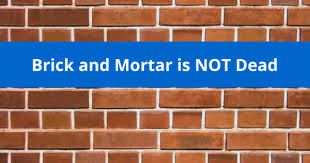It is now a widely accepted fact of life that e-commerce retailers are set to overtake brick-and-mortar stores in the near future. Although online spending accounted for approximately 16% of the total retail sales in 2019, there has never been a significant dip in its growth rate and experts anticipate a promising future.
As shopping malls across tech savvy nations like the United States close, traditional retailers have begun seeking a means of survival. Today, brick-and-mortar stores still hold many advantages over their online counterparts, the trick now is to play into them while diversifying.
The Potential in Brick-and-Mortar

Certain categories of retail are simply more apt for the online environment than they ever were for physical stores. Amazon is notorious for the role it played in closing down small bookstores, in fact Amazon initially started off as an online bookseller itself.
The book industry was ripe for the picking. Books take up a lot of room, and when combined with the costs of renting a commercial space and displaying their stock, the overhead was enormous. Conversely, Amazon only needed to maintain a single website while their stock sat in warehouses. So, why then has Amazon started to open physical bookstores across the U.S.?
It’s a combination of many factors, but the key aspect here seems to be that there’s now a gap in the market. Borders was liquidated in 2011, since then Barnes and Nobel closed 10% of their stores. As bookstores closed, there’s one thing Amazon couldn’t offer their market, the bookstore experience.
Brick-and-Mortar stores offer their customers a tactile experience. In some cases, it’s obvious how they may capitalize on this, such as furniture or fashion outlets where customers can interact with the product, but in others it takes more initiative.
Combining E-Commerce and Brick-and-Mortar

Even as our digital world expands, it’s clear our physical world still takes precedence. Amazon isn’t the only e-commerce retailer venturing into brick-and-mortar, they’re accompanied by digital giants like Bonobos and Indochino, both are fashion retailers seeking to accommodate physical experiences.
E-Commerce stores are beginning to recognize the value of the customer experience, but brick-and-mortar stores seem to be falling behind. Only 28% of small businesses offer e-commerce options to their customers, a growing but disappointing number.
Granted, stores have begun utilizing their physical presence through demonstrations, events, and marketing campaigns. But despite the advantages of brick-and-mortar stores, they can’t compete with the convenience and discounts offered online. A largely overlooked fact is that they don’t have to. Following the lead of successful e-commerce retailers, diversifying their field of operations may be their most viable route to longevity.
Pioneering brick-and-mortar stores have taken the initiative by offering pick-ups, delivery, and drop shipping options, which have proven highly successful. For example, the CEO of Medly Pharmacy noted a boost in sales when they began offering the option to fill prescriptions online. Additionally, 44% of consumers indicate pick-up options would aid their shopping.
The impact of e-commerce on traditional retail is still being studied, but ultimately e-commerce has served to up the standards maintained by brick-and-mortar stores for far too long. As the market develops, e-commerce and brick-and-mortar stores seem better fitted to work in tandem than as competitors, as the lines between the two continue to blur.

